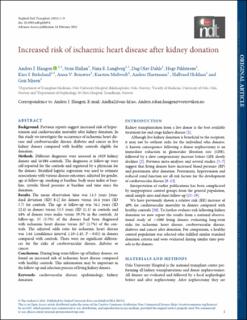| dc.contributor.author | Haugen, Anders Johan Smedman | |
| dc.contributor.author | Hallan, Stein | |
| dc.contributor.author | Langberg, Nina Elisabeth Borthen | |
| dc.contributor.author | Dahle, Dag Olav | |
| dc.contributor.author | Pihlstrøm, Hege K. | |
| dc.contributor.author | Birkeland, Kåre Inge | |
| dc.contributor.author | Reisæter, Anna Varberg | |
| dc.contributor.author | Midtvedt, Karsten | |
| dc.contributor.author | Hartmann, Anders | |
| dc.contributor.author | Holdaas, Hallvard | |
| dc.contributor.author | Mjøen, Geir | |
| dc.date.accessioned | 2022-03-28T14:18:18Z | |
| dc.date.available | 2022-03-28T14:18:18Z | |
| dc.date.created | 2022-01-11T13:02:15Z | |
| dc.date.issued | 2021 | |
| dc.identifier.issn | 0931-0509 | |
| dc.identifier.uri | https://hdl.handle.net/11250/2988112 | |
| dc.description.abstract | Background
Previous reports suggest increased risk of hypertension and cardiovascular mortality after kidney donation. In this study we investigate the occurrence of ischaemic heart disease and cerebrovascular disease, diabetes and cancer in live kidney donors compared with healthy controls eligible for donation.
Methods
Different diagnoses were assessed in 1029 kidney donors and 16 084 controls. The diagnoses at follow-up were self-reported for the controls and registered by a physician for the donors. Stratified logistic regression was used to estimate associations with various disease outcomes, adjusted for gender, age at follow-up, smoking at baseline, body mass index at baseline, systolic blood pressure at baseline and time since the donation.
Results
The mean observation time was 11.3 years [standard deviation (SD) 8.1] for donors versus 16.4 years (SD 5.7) for controls. The age at follow-up was 56.1 years (SD 12.4) in donors versus 53.5 years (SD 11.1) in controls and 44% of donors were males versus 39.3% in the controls. At follow-up, 35 (3.5%) of the donors had been diagnosed with ischaemic heart disease versus 267 (1.7%) of the controls. The adjusted odds ratio for ischaemic heart disease was 1.64 (confidence interval 1.10–2.43; P = 0.01) in donors compared with controls. There were no significant differences for the risks of cerebrovascular disease, diabetes or cancer.
Conclusions
During long-term follow-up of kidney donors, we found an increased risk of ischaemic heart disease compared with healthy controls. This information may be important in the follow-up and selection process of living kidney donors. | en_US |
| dc.language.iso | eng | en_US |
| dc.publisher | Oxford University Press | en_US |
| dc.rights | Navngivelse-Ikkekommersiell 4.0 Internasjonal | * |
| dc.rights.uri | http://creativecommons.org/licenses/by-nc/4.0/deed.no | * |
| dc.title | Increased risk of ischaemic heart disease after kidney donation | en_US |
| dc.type | Peer reviewed | en_US |
| dc.type | Journal article | en_US |
| dc.description.version | publishedVersion | en_US |
| dc.source.journal | Nephrology, Dialysis and Transplantation | en_US |
| dc.identifier.doi | 10.1093/ndt/gfab054 | |
| dc.identifier.cristin | 1978324 | |
| cristin.ispublished | true | |
| cristin.fulltext | original | |
| cristin.qualitycode | 1 | |

